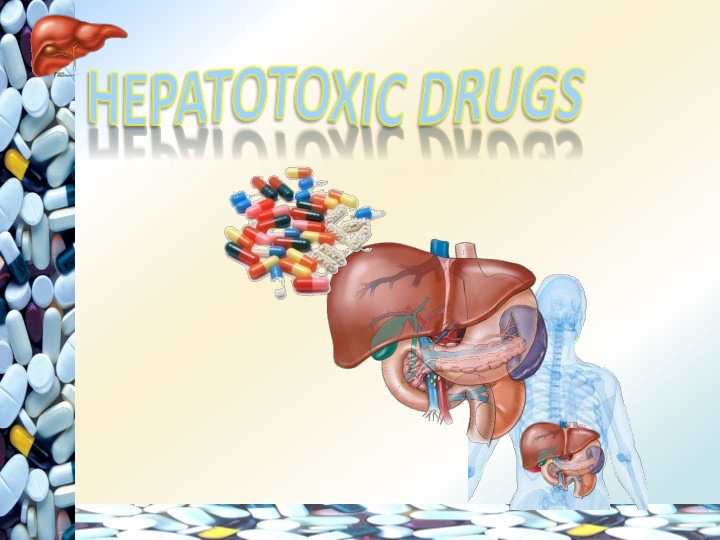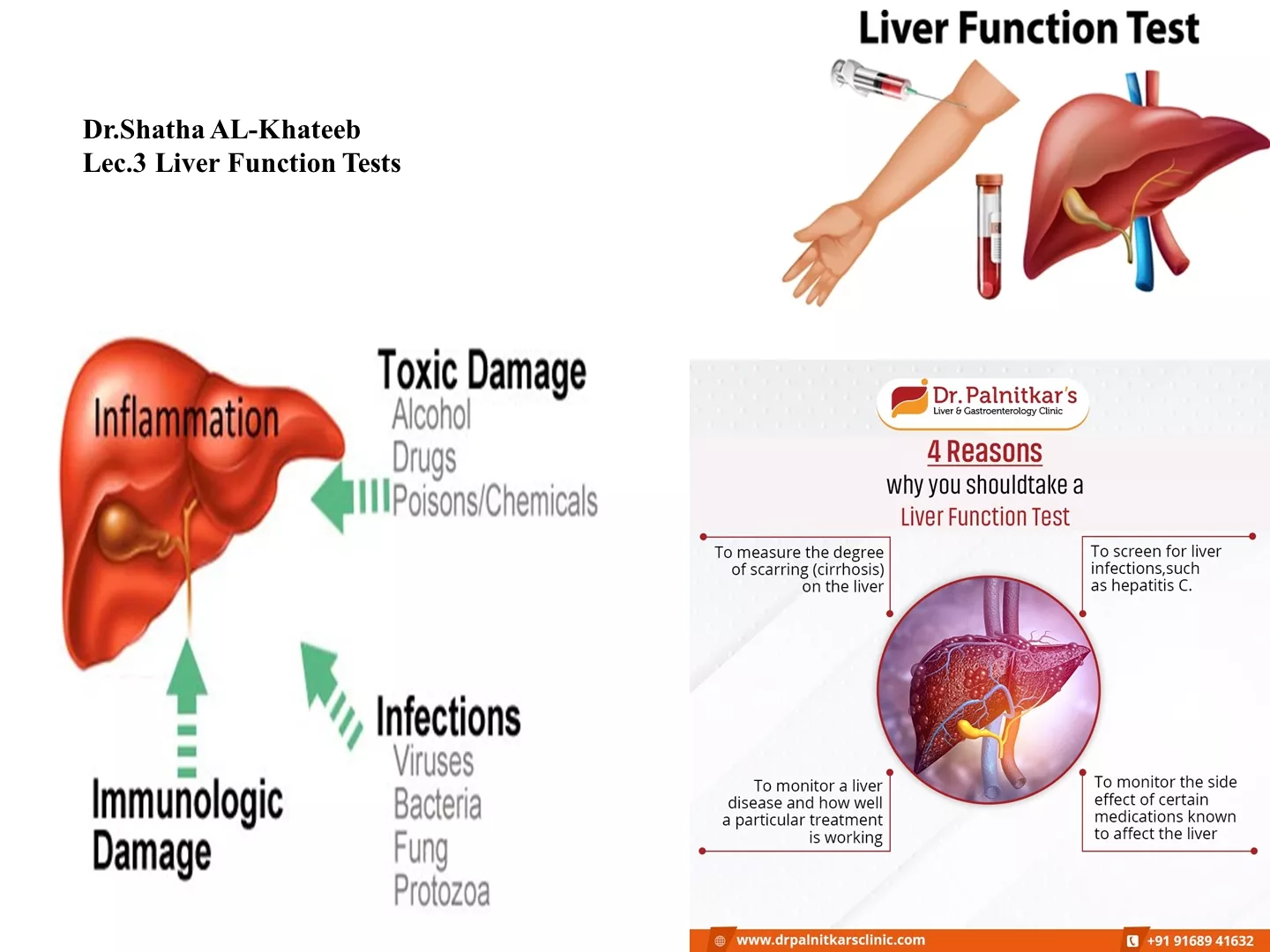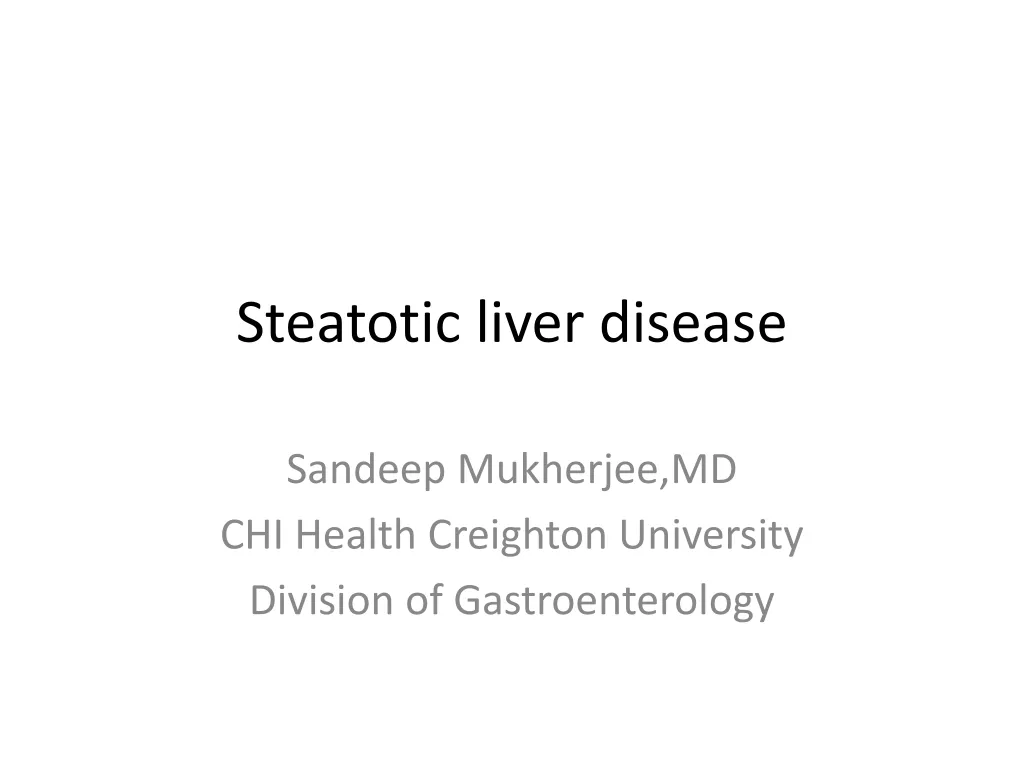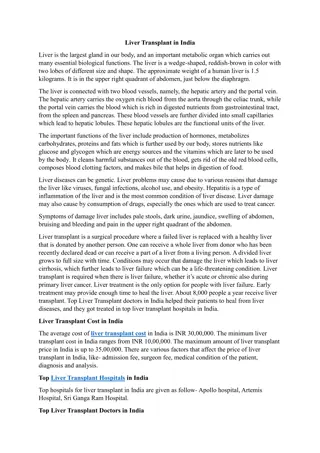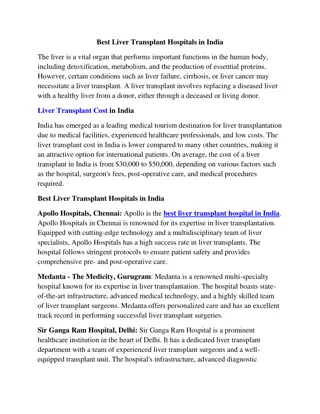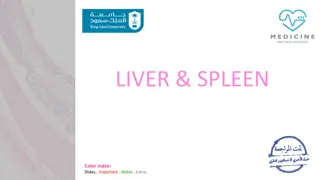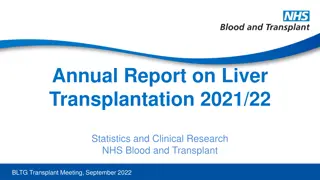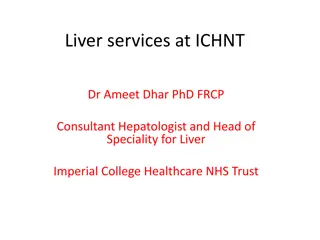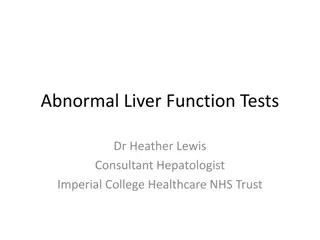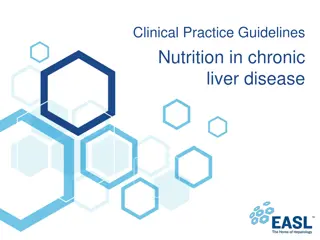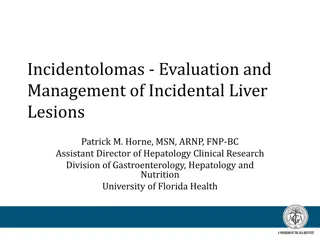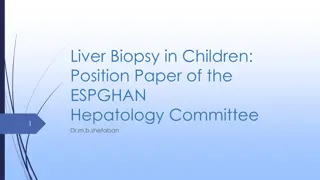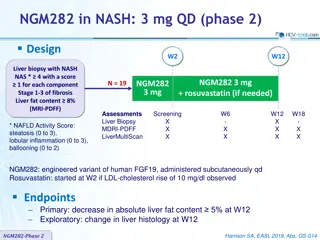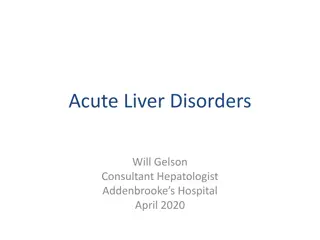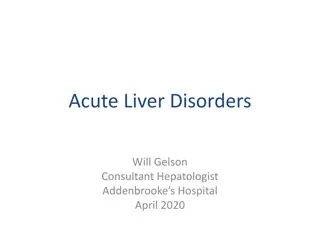Hepatotoxic Drugs: Liver's Role in Detoxification & Clinical Consequences
Understand the impact of hepatotoxic drugs on liver function, including detoxification processes, hepatotoxicity patterns, classification of hepatotoxins, mechanisms of liver injury, clinical presentations, and possible treatments. Explore how drug metabolism transforms substances into toxic intermediates, leading to drug-induced liver injury with varying impairments like hepatitis, inflammation, apoptosis, and necrosis.
Download Presentation

Please find below an Image/Link to download the presentation.
The content on the website is provided AS IS for your information and personal use only. It may not be sold, licensed, or shared on other websites without obtaining consent from the author.If you encounter any issues during the download, it is possible that the publisher has removed the file from their server.
You are allowed to download the files provided on this website for personal or commercial use, subject to the condition that they are used lawfully. All files are the property of their respective owners.
The content on the website is provided AS IS for your information and personal use only. It may not be sold, licensed, or shared on other websites without obtaining consent from the author.
E N D
Presentation Transcript
HEPATOTOXIC DRUGS ILOs Define the role of liver in drug detoxification Discuss the types (patterns) of hepatotoxicity Classify hepatotoxins Explain how a drug can inflict hepatotoxicity State the pathological consequences of hepatic injury Contrast the varied clinical presentation of hepatotoxicity Enlist the possible treatment
PHYSIOLOGICAL has multiple functions (>5000) 1. Regulation, synthesis & secretion. proteins + bile for digesting fats. 2. Storage. Glucose (as glycogen), fat soluble vitamins (A, D, E & K) & minerals 3. Purification, transformation & clearance hormones, cholestrol, FA, & proteins..) & exogenous (drugs, toxins, herbs etc ) chemicals. can be categorized into: utilization of glucose, lipids & of endogenous (steroid Human body identifies almost all drugs as foreign substances i.e. XENOBIOTIC Has to get rid of them PHARMACOLOGICAL "METABOLIC CLEARING HOUSE"
HEPATOTOXIC DRUGS Subjects drugs to chemical transformation (METABOLISM) become inactive & easily excreted. Since most drugs are lipophilic they are changed into hydrophilic water soluble products suitable for elimination through the bile or urine to Such metabolic transformation usually occur in 2 PHASES: Phase 1 reactions Oxidation, Reduction, Hydrolysis, Hydration Catalyzed by CYT P-450 Yields intermediates polar, transient, usually highly reactive far more toxic than parent substrates may result in liver injury Drug Induced Liver Injury (DILI) Yields products of increased solubility If of high molecular weight excreted in bile If of low molecular weight excreted in urine Phase 2 reactions Conjugation with a moiety (acetate, a.a., glutathione, glucuronic a., sulfate ) to blood
Hepatotoxicity Is the Leading cause of ADRs HEPATOTOXIC DRUGS DRUG INDUCED LIVER INJURY Injury / damage of the liver Caused by exposure to a drug Inflict varying impairment in liver functions Manifests clinically a long range hepatitis failure Inflammation Apoptosis Necrosis
HEPATOTOXIC DRUGS Why the liver is the major site of ADRs ? Why the liver is the major site of ADRs ? It is the first organ to come in contact with the drug after absorption from the GIT. Being the metabolic clearing house of the body highest levels of drug metabolizing enzymes that converts some drugs( PROTOXINS) into intermediate (TOXINS) before being conjugated for elimination it expresses the Drug (Pro-toxin) Paracetamol Toxin NABQI Injury centrilobular CYT P450 (NAPBQI) : N-acetyl-p-benzoquinone imine
HEPATOTOXIC DRUGS Can any drug cause liver Can any drug cause liver- -related ADRs ? Not all drugs do so. Drugs that can cause ADRs in the liver (hepatotoxicity) are called HEPATOTOXIN TOXICITY POTENTIAL OF THE DRUG Chemical composition of the drug itself Nature of its reactive metabolite Conjugation reactions linked to it & their availability Mitochondrial effects of the drug Drug formulation etc related ADRs ?
HEPATOTOXIC DRUGS 1. Nature of a 1. Nature of a Hepatotoxin induced hepatotoxic hepatotoxic ADRs it inflicts ? Hepatotoxin 2.Types of drug 2.Types of drug- -induced ADRs it inflicts ? If the toxicity of HEPATOTOXIN is inflicted by: SUPERTHERAPEUTIC or CUMULATIVE DOSE of the drug INTRINSIC HEPATOTOXIN The hepatotoxicity it inflicts is DIRECT HEPATOTOXICITY belong to TYPE A ADRs: PREDICTABLE / DIRECT If the toxicity is inflicted by NORMAL DOSE of the drug IDIOSYNCRATICHEPATOTOXIN The hepatotoxicity it inflicts is INDIRECT HEPATOTOXICITY belong to TYPE B ADRs: UNPREDICTABLE / BIZZAR / IDIOSYNCRATIC
Types of drug Types of drug- -induced induced hepatotoxic hepatotoxic ADRs ? ADRs ? 1. DIRECT HEPATOTOXICITY caused by INTRINSIC HEPATOTOXIN Type A Type A Dose-dependent hepatotoxicity Direct increased dose dependent hepatotoxicity Acetaminophen Salicylates Statins Amiodarone Methotrexate Oral contraceptives Cumulative Dose/effect Alcohol Increased & Cumulative Doses/effect Increased Dose Increased Dose Increased Dose Cumulative Dose/effect Increased & Cumulative Direct cumulative hepatotoxicity
2. INDIRECT HEPATOTOXICITY caused by IDIOSYNCRATIC HEPATOTOXIN Dose-independent hepatotoxicity divided into: Type B Type B Hypersensitivity or immunoallergic reactions Metabolic-idiosyncratic reactions 2.a. Immunoallergic Idiosyncratic Hepatotoxicity Type B Type B A drug or its metabolite binds to hepatic membranes or proteins act as hapten to induce a variety of immune reactions Inflammatory cholestasis Chlorpromazine. Chlorpropamide. Erythromycin. Viral hepatitis-like pattern Isoniazid. Phenytoin. Methyldopa.
2. INDIRECT HEPATOTOXICITY caused by IDIOSYNCRATIC HEPATOTOXIN 2.b. Metabolic Idiosyncratic Hepatotoxicity TypeB TypeB The metabolite of the offending drug interferes with hepatic metabolism as that of bilirubin or protein synthesis .etc Interfere with bilirubin metabolism Erythromycin Rifampicin Interfere with protein synthesis Corticosteroids Tetracycline N.B. Not all drugs fall neatly into one of these categories, and overlapping mechanisms may occur with some drugs
HOW CAN A DRUG INDUCE HEPATOTOXICITY ? HOW CAN A DRUG INDUCE HEPATOTOXICITY ? Drug or its reactive metabolites can form covalent bonds with target molecules or alter the target molecule by non-covalent interactions or both COVALENT INTERACTIONS It is adduct formation between the metabolite of the drug & cellular macromolecules If covalent binding to protein immunogenic reaction If binding to DNA carcinogenesis NON-COVALENT INTERACTIONS - Lipid peroxidation - Impairment of mitochondrial respiration - Depletion of GSH reactions - Modification of sulfhydryl groups - Protein synthesis inhibition ..etc generation of cytotoxic oxygen radicals 'oxidative stress' impair Ca2+homostasis
Do Do hepatotoxins hepatotoxins cause liver disease in all persons ? cause liver disease in all persons ? Most hepatotoxins cause liver disease only in certain persons depending on; HOST ENVIRONMENTAL HOST FACTORS Race / Age / Sex / Nutritional status Concomitant habits / drugs / diseases GENETIC MAKEUP Metabolizing Enzymes Detoxifying System Drug Transport
HEPATOTOXIC DRUGS DRUG INDUCED LIVER INJURY
DRUG INDUCED HEPATIC INJURY DRUG INDUCED HEPATIC INJURY Is DIHI common ? Is DIHI common ? INCIDENCE of DILI Drugs produce about 10% of all cases of hepatitis in young adults and 40% of cases in patients older than 50 years. Are certain persons or population more susceptible ? Are certain persons or population more susceptible ? Upon exposure to hepatotoxins people are categorized as; Tolerators No injury Adaptors Mild transient injury but adapt Susceptibles Develop overt symptoms depending on existing predisposing factors In Threat ; DILI accelerates beyond initial targets due to loss of synthetic & clearance function of hepatocyte with recruitment of inflammatory cells provoke apoptotic & necrotic signals TOXICITY POTENTIAL OF THE DRUG HOST GENETIC MAKEUP ENVIRONMENTAL HOST FACTORS
What are the presenting manifestations? What are the presenting manifestations? Individual drugs tend to have CHARACTERISTIC SIGNATURE composed of: A particular latency period A clinical pattern A particular pathological finding LATENCY PERIOD short (hrs/dys), intermediate (1-8ws), long (1-12ms) In Direct dose-dependent Hepatotoxicity Latency period SHORT as it occurs after a threshold of toxicity is reached acetaminophen ( toxic dose) In Direct cumulative or In Indirect Immunoallergic Idiosyncratic Hepatotoxicity Latency period INTERMEDIATE but may continue to evoke even after drug
CLINICAL PATTERNS The clinical presentation could be of variable intensity, ranging from asymptomatic of liver enzymes fulminant hepatic failure Phenytoin Statins Sulfonamides Sulfonylureas Some drugs just induce IN AMINOTRANSFERASES ASYMPTOMATIC Other drugs induce SYMPTOMATIC MANIFESTATIONS If injury targets hepatocytes apoptosis or necrosis HEPATITIS (cytotoxic) develops rapid onset of malaise, severe anorexia and jaundice + in alanine aminotransferases (ALT) If injury targets biliary system (canalicular or ductal) CHOLESTASIS develop jaundice + severe pruritus predominate in alkaline phosphatase (ALP ) + hyperbilirubinaemia If injury targets both hepatocytes & biliary system MIXED TYPE
Some PATTERNS of SYMPTOMATIC drug-induced liver disease Hepatic injury Hepatocellular Cholestatic Mixed Flu-like, malaise, m. aches weakness, loss of appetite, GIT symptoms, diarrhea, jaundice, urine discolored, 3 fold rise Yellowish discoloration of skin, dark urine, rash, pruritus, stool may be light Normal or slight ALT 3 fold rise ALP Normal 2 fold rise 2 fold rise Phenytoin Carbamazepine Sulfonamides ACE Inhibitors Acetaminophen NSAIDs Isoniazid Amiodarone Chlorpropamide Erythromycin Rifamycin Oral contraceptives Examples
A long standing rheumatoid arthritic patient developed tuberculosis 2 month ago. Today she was received in E.R complaining of yellowish discoloration of skin, severe anorexia, vomiting and flue like manifestations since two days. She is very weak and looks toxic. Her drug history reveals that she has been 4 month ago on cyclosporine to control the arthiritic exacerbations. A month ago, she was put on isoniazid when she developed T.B. and multivitamins because she is weak. Currently she is given domperidone for the emesis. Lab results reveals severe elevation in ALT but no elevation in ALP. Hepatocellular Which one of the following drugs is the likely cause of her symptoms? a. Cyclosporine b. Multivitamines c. Isoniazid d. Domperidone Which type of hepatotoxin is it considered? What is the likely hepatotoxic pattern inflicted by the drug? Treatment????
A hypercholestrolemic patient was received in E.R complaining of yellowish discoloration of skin, change in color of urine & stools, and severe itching. He has been receiving statins fro the long time for the hypercholestrolemia. Three month ago he was diagnosed as being diabetic and hypertensive and since then he is receiving chlorpropamide for the diabetes and nadolol for the hypertension. The last couple of days he had a flue; for which he was given acetaminophen for muscle aches and nasal drops for his nasal stuffiness. Lab investigations shows severe elevation in ALP and no significant elevation in ALT Cholestatic Which one of the following drug is the likely cause of his symptoms? a. Nadolol b. Chlorpropamide Which type of hepatotoxin it is considered? What is the hepatotoxic pattern inflicted by the drug? c. Acetominophen d. Statins Treatment????
HISTOPATHOLOGICAL PATTERNS No universal histo-pathological pattern of DIHI exist. The commonest are; Hepatocellular necrosis Cholestasis Steatosis More than one type of injury may occur in the same patient Any one agent may produce different types of injury in different patients Ballooning & degeneration of hepatocyte Centrilobular & midzonal necrosis Cholistatic injury with damaged bile duct Fatty accumulation
What are the lines of treatment? What are the lines of treatment? Immediate withdrawal of any suspected drug No specific treatment largely symptomatic & supportive Symptomatic; If a severe allergic reaction is observed Corticosteroids If pruritus enhance bile acid excretion Cholestyramine If cholestatic liver injury Ursodeoxycholic acid (Ursodiol) If coagulopathy or encephalopathy develop treat accordingly Supportive; High carbohydrate, moderate protein diet adequate in calories Specific antidotes N-acetylcysteine acetaminophen toxicity L-carnitine valproate toxicity Emergency liver transplantation for drug induced fulminant hepatic failure
